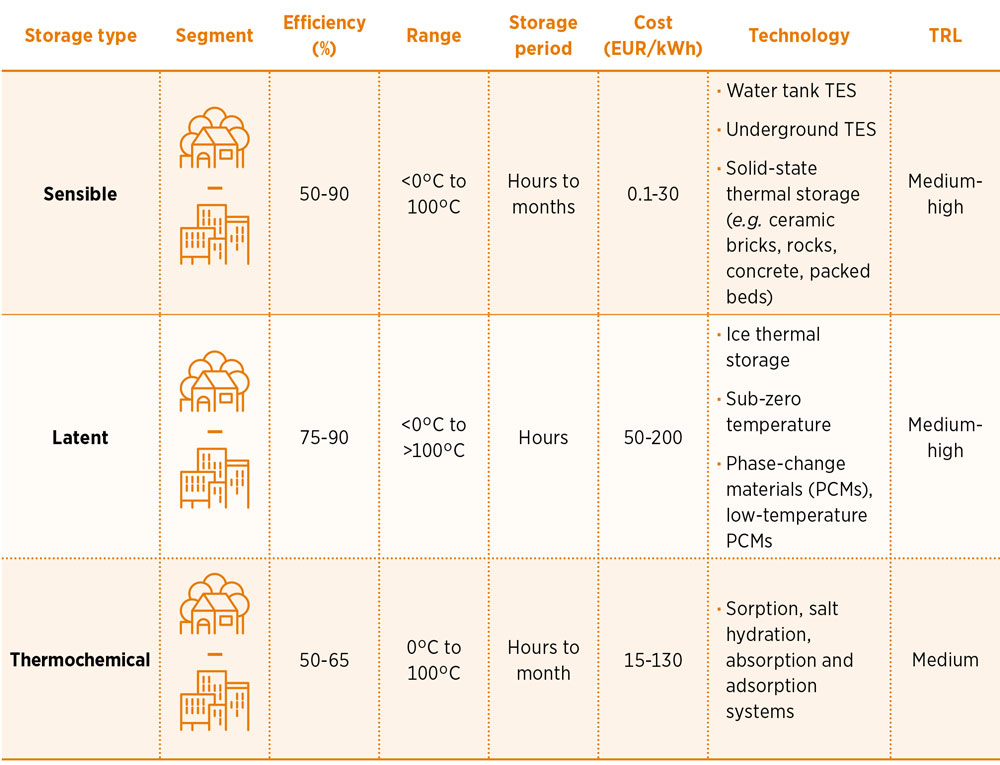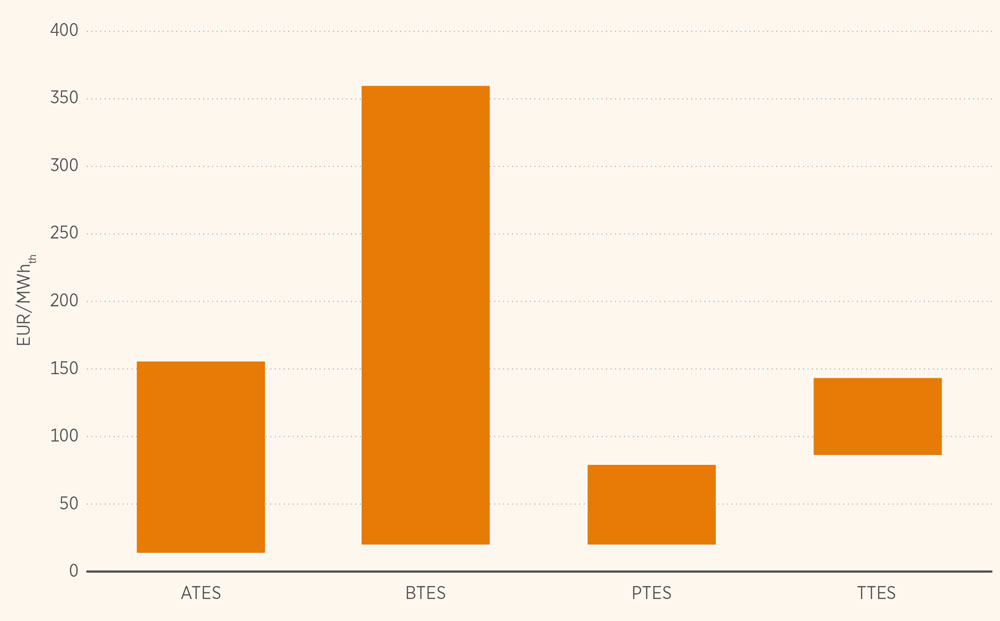Low-temperature thermal energy storage
Overview of the status and impact of the innovation

What
Low-temperature TES accumulates heat (or cooling) over hours, days, weeks or months and then releases the stored heat or cooling when required in a temperature range of 0-100°C. Storage is of three fundamental types (also shown in Table 6.3):
- Sensible storage of heat and cooling uses a liquid or solid storage medium witht high heat capacity, for example, water or rock.
- Latent storage uses the phase change of a material to absorb or release energy.
- Thermochemical storage stores energy as either the heat of a reversible chemical reaction or a sorption process.
TABLE 6.3 Low-temperature technological alternatives for TESs

Notes: EUR/kWh = euros per kilowatt hour; TES = thermal energy storage; TRL = technology readiness level.
Why
By decoupling heating and cooling demands from electricity consumption, thermal storage systems allow the integration of greater shares of variable renewable generation, such as solar and wind power. They can also reduce the peak electricity demand and the need for costly grid reinforcements, and even help in balancing seasonal demand. Thermal storage can add increasing benefits to the grid the longer the heat can be stored. The economics are difficult, however, due to the limited number of cycles and the decline in the prices of competing battery storage (Box 6.5). TES systems, therefore, must be low cost.
BOX 6.5 Seasonal aquifer storage of Stockholm’s airport
Stockholm’s Arlanda Airport has the world’s largest aquifer storage unit. It contains 200 million m3 of groundwater and can store 9 GWh of energy. One section holds cold water (at 3-6°C), while another has water heated to 15-25°C. The system works like a giant seasonal thermos: during summer, cold water is pumped to provide cooling for the airport’s district heating and cooling system. The water is returned to the aquifer at a temperature of 20°C. Warm water is then used in winter to preheat the ventilation air in the buildings and melt snow on aircraft parking areas.
BOX 6.6 Economics of thermal storage
The economics of thermal storage depends on multiple factors, including energy prices, the energy demand served by the storage, the specific storage technologies and storage size (with costs decreasing as storage volumes increase). Figure 6.6 shows the levelised cost of heat (LCoH) for different seasonal storage technologies. Some of the technologies have a wide range of LCoHs, showing the high dependence of costs on specific project conditions. However, the average cost of small-scale hot water thermal storage is approximately USD 100/kWh (Lund et al., 2016), which is still considerably lower than the average cost of battery storage, despite the rapid decline in battery costs from almost USD 3 000/kWh in 2014 to USD 850/kWh in 2021 (IRENA, 2022d).
FIGURE 6.6 Levelised cost of heat for seasonal thermal storage technologies

Notes: ATES = aquifer thermal energy storage; BTES = borehole thermal energy storage; EUR/MWhth = euros per kilowatt hour thermal; PTES = pit thermal energy storage; TTES = tank thermal energy storage.
Related kits
Power to heat and cooling innovations
Innovations (35)
-
Technology and infrastructure
- 1 Low-temperature heat pumps
- 2 Hybrid heat pumps
- 3 High-temperature heat pumps
- 4 Waste heat-to-power technologies
- 5 High-temperature electricity-based applications for industry
- 6 Low-temperature thermal energy storage
- 7 Medium- and high-temperature thermal energy storage
- 8 Fourth-generation DHC systems
- 9 Fifth-generation DHC systems
- 10 Internet of Things for smart electrification
- 11 Artificial intelligence for forecasting heating and cooling demands
- 12 Blockchain for enabling transactions
- 13 Digitalisation as a flexibility enabler
-
Market design and regulation
- 14 Dynamic tariffs
- 15 Flexible power purchase agreement
- 16 Flexible power purchase agreement
- 17 Standards and certification for improved predictability of heat pump operation
- 18 Energy efficiency programmes for buildings and industry
- 19 Building codes for power-to-heat solutions
- 20 Streamlining permitting procedures for thermal infrastructure
-
System planning and operation
-
Business models
- 28 Aggregators
- 29 Distributed energy resources for heating and cooling demands
- 30 Heating and cooling as a service
- 31 Waste heat recovery from data centres
- 32 Eco-industrial parks and waste heat recovery from industrial processes
- 33 Circular energy flows in cities – booster heat pumps
- 34 Community-owned district heating and cooling
- 35 Community-owned power-to-heat assets